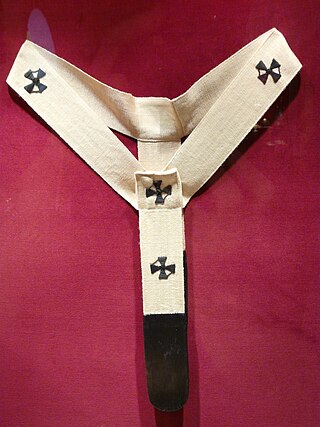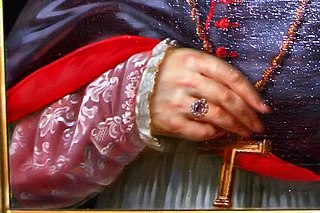
The pallium is an ecclesiastical vestment in the Catholic Church, originally peculiar to the Pope, but for many centuries bestowed by the Holy See upon metropolitans and primates as a symbol of their conferred jurisdictional authorities, and still remains a papal emblem.

The Tridentine Mass, also known as the Traditional Latin Mass or the Traditional Rite, is the liturgy in the Roman Missal of the Catholic Church published from 1570 to 1962. Celebrated almost exclusively in Ecclesiastical Latin, it was the most widely used Eucharistic liturgy in the world from its issuance in 1570 until the introduction of the Mass of Paul VI.

A papal coronation is the formal ceremony of the placing of the papal tiara on a newly elected pope. The first recorded papal coronation was of Pope Nicholas I in 858. The most recent was the 1963 coronation of Paul VI, who soon afterwards abandoned the practice of wearing the tiara. To date, none of his successors have used the tiara, and their papal inauguration celebrations have included no coronation ceremony, although any future pope may elect to restore the use of the tiara at any point during his pontificate.

In the teaching of the Catholic Church, an indulgence is "a way to reduce the amount of punishment one has to undergo for sins". The Catechism of the Catholic Church describes an indulgence as "a remission before God of the temporal punishment due to sins whose guilt has already been forgiven, which the faithful Christian who is duly disposed gains under certain prescribed conditions through the action of the Church which, as the minister of redemption, dispenses and applies with authority the treasury of the satisfactions of Christ and all of the saints".

A Pontifical High Mass, also called Solemn Pontifical Mass, is a Solemn or High Mass celebrated by a bishop using certain prescribed ceremonies. Although in modern English the word "pontifical" is almost exclusively associated with the pope, any bishop may be properly called a pontiff. Thus, the celebrant of a Pontifical High Mass may be the pope, any bishop or any other prelate who is allowed to wear pontificals.
In the Catholic Church, the Apostolic Pardon is an indulgence given for the remission of temporal punishment due to sin. The Apostolic Pardon is given by a priest, usually along with Viaticum. It is not usually given as part of the sacrament of Anointing of the Sick. However, if the Anointing of the Sick is given with Viaticum, in exceptional circumstances or an emergency, it may be given then..

A papal conclave is a gathering of the College of Cardinals convened to elect a bishop of Rome, also known as the pope. Catholics consider the pope to be the apostolic successor of Saint Peter and the earthly head of the Catholic Church.

A Papal Mass is the Solemn Pontifical High Mass celebrated by the Pope. It is celebrated on such occasions as a papal coronation, an ex cathedra pronouncement, the canonization of a saint, on Easter or Christmas or other major feast days.

The Apostolic Penitentiary, formerly called the Supreme Tribunal of the Apostolic Penitentiary, is a dicastery of the Roman Curia and is one of the three ordinary tribunals of the Apostolic See. The Apostolic Penitentiary is chiefly a tribunal of mercy, responsible for issues relating to the forgiveness of sins in the Catholic Church.

Urbi et Orbi denotes a papal address and apostolic blessing given by the pope on certain solemn occasions.

The mozzetta is a short elbow-length sartorial vestment, a cape that covers the shoulders and is buttoned over the frontal breast area. It is worn over the rochet or cotta as part of choir dress by some of the clergy of the Catholic Church, among them the pope, cardinals, bishops, abbots, canons and religious superiors. There used to be a small hood on the back of the mozzetta of bishops and cardinals, but this was discontinued by Pope Paul VI. The hood, however, was retained in the mozzette of certain canons and abbots, and in that of the popes, often trimmed in satin, silk or ermine material.

Portiuncula, also spelled Porziuncola or Porzioncula, is a small Catholic church located within the Papal Basilica of Saint Mary of the Angels in Assisi in the frazione of Santa Maria degli Angeli, situated about 4 kilometres (2.5 mi) from Assisi, Umbria. It is the place from where the Franciscan movement started.

A canonical coronation is a pious institutional act of the pope, duly expressed in a formal decree of a papal bull, in which the pope bestows the pontifical right to impose an ornamental crown, a diadem or an aureole to an image of Christ, Mary or Joseph that is widely venerated in a particular diocese or locality.

An ecclesiastical ring is a finger ring worn by clergy, such as a bishop's ring.
Pontifical vestments, also referred to as episcopal vestments or pontificals, are the liturgical vestments worn by bishops in the Catholic, Eastern Orthodox, Oriental Orthodox, Anglican, and some Lutheran churches, in addition to the usual priestly vestments for the celebration of the mass, other sacraments, sacramentals, and canonical hours. The pontifical vestments are only worn when celebrating or presiding over liturgical functions. As such, the garments should not be confused with choir dress, which are worn when attending liturgical functions but not celebrating or presiding.

The Raccolta, is a book, published in many editions from 1807 to 1952, that collected the texts of Roman Catholic prayers and briefly described other acts of piety, such as visiting and praying in particular churches, for which specific indulgences were granted by popes. In 1968, it was replaced by a considerably altered edition, the Enchiridion Indulgentiarum, listing fewer specific prayers but including new general grants that apply to a wide range of prayerful actions. The earliest editions were published in Italian, with the prayers themselves given in Latin, Italian, or both languages. Beginning with the 1929 edition, the Raccolta was published in Latin, with the prayers themselves given in Latin, Italian, or to a lesser degree, French, Spanish, English, and German.
Indulgentarium Doctrina is an apostolic constitution about indulgences issued by Pope Paul VI on 1 January 1967. It responds to suggestions made at the Second Vatican Council, it substantially revised the practical application of the traditional doctrine relating to indulgences. The title is taken from the opening words of the original Latin text.
A Privileged Altar was an altar in a Roman Catholic church where a plenary indulgence could be applied in favor of a soul in purgatory by the priest celebrating Mass whenever Mass was celebrated there. This was an additional indulgence, over and above the graces and benefits normally flowing from the celebration of Mass.

The episcopal or pontifical blessing is a blessing imparted by a bishop, especially if using a formula given in official liturgical books.
Events in the year 2020 in Vatican City.
















